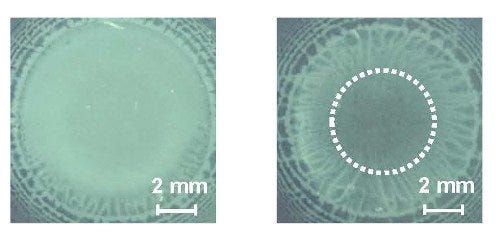June 16, 2016
Using a terahertz laser, researchers were able to bring about permanent changes in the molecular structure of a polymer.
Kristopher Sturgis

Low-magnification reflection images obtained by polarized microscope.
The dash lines show the irradiated terahertz wave beam size.
For the first time ever, scientists have induced permanent changes in the conformation of a polymer using a terahertz laser--a discovery that could have a significant impact on macromolecular science and provide a tool to control the structure of molecules in new materials.
The discovery was made by a team of scientists at the RIKEN Center for Advanced Photonics (RAP) in Japan and became the first demonstration of inducing permanent changes in the conformation of a polymer when they increased the pattern of crystallization. Hiromichi Hoshina, senior scientist at RAP and one of the lead authors on the work, said the mechanism that makes this discovery possible is still unknown to the group, but the result is an important first step to understanding the implications.
"The mechanism is still a mystery, but we hope to make it clear," Hoshina said. "The phenomena we found this time is new to terahertz scientists, but the meaning of this breakthrough for me is that we first realized the ability of terahertz wave changing the macromolecular structure, which is the origin of their properties and functions. However, because the physical mechanism is still unclear, we cannot precisely predict what we can do with this technique. We've just made the first step, and we have to continue the research to clarify the mechanism."
The terahertz laser offers promise as a technique that could allow scientists to modify materials, paving the way to alter the characteristics of different materials, including proteins. In the case of proteins, the technique could even be used to make it either possible or impossible to perform certain biological functions, Hoshina said.
"It would be wonderful if terahertz wave changes can alter the protein structure and functions," he added. "But I think that could be difficult because of the intense absorption of water. Most of the protein functions appear in water solution, but if we irradiate terahertz waves to water solution, water will absorb more than 99% of the energy. We have to invent a technique that can transfer terahertz energy to protein, which will be a big challenge."
Through trial and error, their experiment finally found success when they were able to irradiate a polymer with terahertz radiation using a terahertz free-electron laser specifically designed by the Institute of Scientific and Industrial Research at Osaka University in Japan. The new laser was able to increase the crystallization of the polymer by 20%, showing for the first time that terahertz waves can permanently rearrange the molecules of a polymer.
As Hoshina stated, the exact mechanism for this rearrangement of molecules remains a question mark for the group, but he speculates that it could be related to the generation of shockwaves in the material, which could explain why the molecules rearrange without breaking the molecular structure. The group plans to investigate this hypothesis as it moves forward with its research.
"The virtue of our method is that terahertz waves do not break the molecular structure," Hoshina said. "Only thermal and mechanical treatment can change the higher order conformation of the macromolecules without changing the molecular structure. We think that our method could become a 'new tool' for the manipulation of the higher order conformation. That kind of new tool could eventually produce new materials--and that may have a big impact, I think."
Kristopher Sturgis is a frequent contributor to Qmed.
[image courtesy of RIKEN CENTER FOR ADVANCED PHOTONICS]
About the Author(s)
You May Also Like


